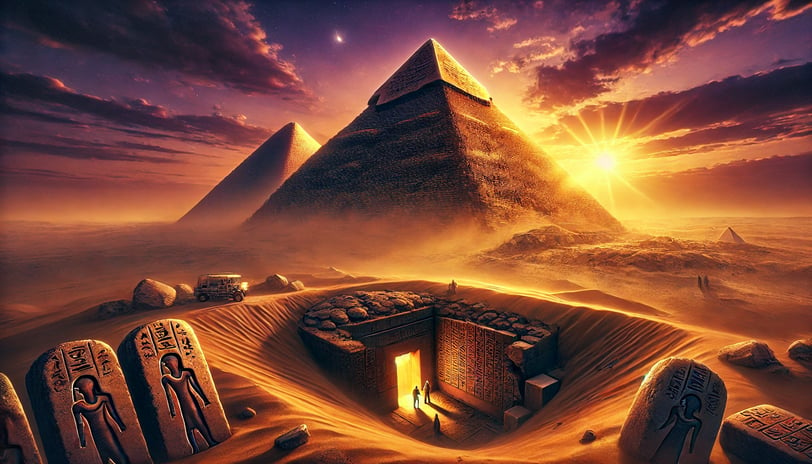The Pyramids of Egypt: Mysteries, Superstitions, and Discoveries
The Pyramids of Egypt have fascinated humanity for millennia. These grand and enigmatic monuments represent not only the ingenuity of ancient Egyptian civilization but also one of the greatest mysteries of archaeology. How were they built? What was their true purpose? What secrets do they still hide? This article explores various theories, superstitions, and recent discoveries surrounding these architectural wonders.
3/6/20253 min read


History and Construction
Egyptian pyramids were primarily built during the Old and Middle Kingdoms, between 2600 and 1500 BCE. The most famous, the Great Pyramid of Khufu, located in Giza, is one of the Seven Wonders of the Ancient World and the only one still standing.
Theories regarding their construction vary. The traditionally accepted method suggests that limestone and granite blocks, weighing several tons, were transported via sand ramps and pulled by thousands of workers. Other scholars propose the use of levers, pulleys, or even a counterweight system. More controversial hypotheses include the use of molded concrete or even unknown technologies.
The Largest Pyramids in Egypt
Egypt is home to many pyramids, but some stand out due to their size and historical significance:
Great Pyramid of Khufu (Cheops) – Built around 2600 BCE, originally standing at approximately 146 meters (now about 138 meters). It was the tallest human-made structure for nearly 4,000 years.
Pyramid of Khafre – Located next to the Great Pyramid, about 136 meters tall, retaining some of its original limestone casing at the top.
Pyramid of Menkaure – The smallest of the three main pyramids in Giza, about 65 meters high.
Red Pyramid – Built by Pharaoh Sneferu, one of the earliest successful smooth-sided pyramids.
Bent Pyramid – Also constructed by Sneferu, it has an unusual shape, possibly due to structural errors or design changes during construction.
Mysteries and Superstitions
The pyramids are surrounded by legends and mystical beliefs. Some of the main mysteries include:
The Curse of the Pharaohs: Many believe that exploring Egyptian tombs brings bad luck and even death, as in the case of Howard Carter's expedition, which discovered Tutankhamun's tomb in 1922. The deaths of several team members fueled the superstition.
Energy and Magnetic Fields: Some researchers and esoteric thinkers believe the pyramids concentrate special energy, possessing healing properties or even generating magnetic fields.
Alignment with the Stars: Studies indicate that the layout of the Giza pyramids aligns with the Orion constellation, raising theories of astronomical influence and even extraterrestrial contact.
Recent Discoveries
Technological advancements have led to new discoveries about the pyramids. Some of the most significant include:
Hidden Chambers: In 2017, an international team used muon scanning technology and detected a large void inside the Great Pyramid, suggesting an unexplored chamber.
Underground Tunnels: Recent excavations indicate complex tunnel systems beneath the pyramids, reinforcing the idea that their purpose went beyond mere tombs.
Artificial Intelligence Applications: Modern algorithms have helped reconstruct maps of ancient Egypt and better understand pharaonic construction techniques.
How Were the Pyramids Built? Different Theories
The construction of the pyramids remains debated. Some theories include:
Human Labor and Ramps: The most accepted theory suggests the use of massive ramps to lift the stone blocks.
Pulleys and Counterweights: Some research points to mechanisms that may have assisted in lifting the stones.
Molded Concrete: A more recent hypothesis suggests the Egyptians might have molded a primitive form of concrete instead of carving and transporting massive blocks.
Lost or Extraterrestrial Technology: Some theorists speculate that advanced civilizations or even extraterrestrials may have assisted in the construction.
Pyramids Around the World and Their Connection
Although Egypt is the most famous location for pyramids, similar structures have been found worldwide, raising hypotheses about possible shared knowledge among ancient civilizations:
Mesoamerican Pyramids: Civilizations like the Maya and Aztecs built impressive pyramids such as Chichén Itzá, Teotihuacán, and Tikal. Some of these pyramids also align with astronomical events.
Chinese Pyramids: Lesser-known, the pyramids of China, such as the Xi’an Pyramid, are attributed to ancient emperors and share structural similarities with Egyptian pyramids.
Bosnian Pyramids: Although controversial, some rock formations in Bosnia have been interpreted as artificial pyramids.
Yonaguni Pyramid (Japan): An underwater formation in Yonaguni sparks debates about whether it is a submerged pyramid, possibly from an unknown civilization.
The similarities between these structures across distant cultures raise questions about possible connections between ancient civilizations. Was it merely coincidence, or was there an exchange of knowledge? Some theories suggest that ancient navigators may have shared construction techniques, while more speculative ideas involve contact with advanced civilizations or extraterrestrials.
Conclusion
The pyramids of Egypt continue to intrigue scientists, archaeologists, and mystery enthusiasts. Despite technological advances, much remains to be discovered about these fascinating monuments. Whether as engineering marvels, religious symbols, or mysterious energy sources, the pyramids remain one of humanity’s greatest legacies and an enigma that continues to challenge our understanding of the past.
Explore
Discover diverse topics in one convenient hub.
Connect
Learn
contact@mindstormblog.com
© 2025. All rights reserved.


